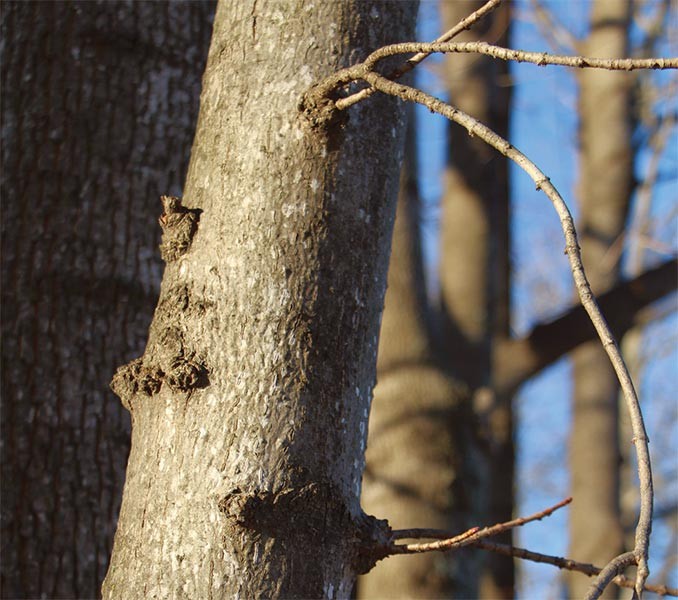I’m interested in learning more about how trees self-prune. How does a tree “decide” that a branch is no longer useful?
Think of it as nature’s cost-benefit analysis. Instead of the landowner or forester choosing which branch to prune and when to prune it, here, the tree makes the call, withholding its investment of food, minerals, and water from any branch that fails to produce at least as much carbohydrate (tree fuel) as it consumes. Any branch that remains a productive contributor, paying its way in the tree’s overall energy budget, will persist. Any that don’t get shut off.
Of course many factors influence this balance between photosynthesis (the food-making) and respiration (the food consuming) within a tree, but access to light is the driver of over-whelming importance. As long as a branch has sufficient light, chances are it will manage to be a net producer, remaining alive and on the tree. This is most readily observed in open-grown trees. With unlimited access to light, they tend to have more live branches, lower down the trunk, for longer durations. In other words, self-pruning is rare in the open.
In the woods, natural pruning is a common occurrence, especially in dense stands where there simply is not enough light for all trees to keep all branches. Accordingly, branches low on the trunk die from shading and competition. They die at varying rates, usually over several growing seasons, and some persist as dead stubs for decades. Immeasurable numbers of shoots and small twigs perish through such self-pruning every day but, surprisingly, it is also a regular occurrence among more sizeable branches on saplings, poles, and sometimes even sawtimber-sized trees.
As any tree becomes overtopped, the amount of light reaching its lowest branches is significantly reduced. This shading reduces the rate of photosynthesis, which in turn leads to a reduction in the number of leaves on the shaded branch as the branch attempts to equalize its energy use. This is a physiological process, beginning with the parent stem sealing the branch off by depositing compounds (resins or gums) at its base. This leads to senescence, or physiological aging, and ultimately to the death of the entire branch.
How long the shaded branch survives varies among tree species, following nicely along the spectrum of shade tolerance. Remember, shade tolerance is the relative capacity of each tree species to compete and survive under shaded conditions. Foresters rank tree species on a continuum from those trees that are very intolerant of shade, like trembling aspen and red pine, to those very tolerant of shade, like American beech and eastern hemlock. Shade-tolerant species are better at balancing photosynthesis and respiration under severely limited light.
And just as shade-tolerant trees can linger in the deeply shaded woods, so too can the lowest branches linger in the darkest depths of a shade-tolerant tree’s crown. Indeed, it’s easy to find living branches on the butt log of a beech or hemlock tree. Shade-intolerant species are very different. They photosynthesize rapidly in full light, which works great in open conditions, but their high photosynthetic rates are offset by similarly prodigal rates of respiration. Under shade, the lower branches of intolerants can’t get enough light to pay their high costs of simply being alive, and they perish. As any walk in the woods will show, lower branches die young on shade-intolerant trees like aspens, paper birch, red pine, elms, ashes, and cherries. They’re known to be good at self-pruning. Typically they have shorter, more open crowns and they naturally occur in lower densities, too.
But there is more to this story. Early death of a branch does not necessarily ensure its early shedding. Although the tree does shut the slacking branch off from receiving nutrients, it cannot sever it. For that, the tree needs outside help; dead branches do not fall until further weakened by fungi, insects, and other agents, such as animals, wind, snow, or ice. Temperature and moisture play a key role through their influence on wood-decaying fungi. Notice how drier branch stubs persist longer.
Natural pruning has significant practical implications for forestry, largely through its influence on tree form and lumber quality. A healthy tree will grow over and around any remaining branch stub (depending on length), forming a knot, then clear wood, and a scar in the bark outside of that. Less healthy trees will exhibit persistent branches and stubs and all manner of malformed scars and wounds in various stages of closure.
The fact is, our forests are filled with these vestiges of foregone branches, naturally pruned over the years by the forest itself.



Discussion *